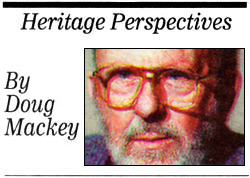 |
March 4, 2005Soaking up the sun and history of
Uruguay
|
MONTEVIDEO, URUGUAY--As
I mentioned recently, I finally got some midwinter sun visiting family in
Montevideo, Uruguay for the last two weeks. Uruguay has a fascinating history,
going back to the early 1700s when the Spanish and Portuguese and later the
British tried to settle there. The country has about 3.2 million people and is
nestled below Brazil to the north and Argentina to the west, on the eastern side
of the world’s widest river, the Rio de la Plata, across from Buenos Aires.
Half of the Uruguayan population lives in Montevideo, the capital city.
 |
Dancers at art show opening at Port
Market.-Doug Mackey photo |
When the Portuguese began to show an
interest in the Spanish settlement in the area, Bruno de Zabala was directed to
create a citadel wall around the early community on the edge of the beautiful
natural harbour. The only major attack on the settlement was later on by the
British in 1802 and was repulsed. Uruguay received its independence on July 18,
1830.
The small early community prospered and
developed an outstanding mercantile and financial district, near the beautiful
old harbour. The city has greatly expanded and the wall has been removed, but
the harbour and financial district remain. Uruguay is now the administrative
centre of a Common Market created among Argentina, Brazil, Paraguay and Uruguay,
and has an important role in economics and policy. The old city is now being
restored and is alive with many tourists from cruise ships that count on
Montevideo as one of their regular ports of call
The old city has numerous historical
sites, some of which I have visited, including museums looking at the early
history. There are some artifacts relating to the original aboriginal population
which is now extinct. Mixed in with all of the historical buildings are
restaurants, bars, stores, art galleries and various markets. The entrance to
the old citadel has been kept intact as a dividing point between the old and new
city, and stands next to the huge Independence Square where there is a monstrous
statue of the national hero of Uruguay, General Jose Gervasio Artigas, astride
his horse.
Tourism
With two million visitors per year, mostly
from neighboring Argentina and Brazil, Uruguay is geared toward providing
excellent service with an airport, buses, hundreds of taxis and very inexpensive
hotel rates. The Montevideo shoreline expressway, known as the Rambla, provides
easy access throughout and into Montevideo and all along the city’s many
beautiful beaches. I have a week’s trip beyond Montevideo planned and will
report on this later.
One of my favorite places is the Port
Market, where I visited an art show opening and have done a lot of shopping and
eating. My son-in-law’s brother is a painter and sells his works in the market
and in nearby galleries. The art opening was for a family friend, who paints
images of the uniquely Uruguayan music called Candombe.
 |
Port Market in Montevideo with
authors Son-in-law and his brother selling paintings.-Doug Mackey photo |
For a whole month, each section of the
city celebrates carnival, with drumming and dancing. Included under the banner
of carnival is the candombe music, whose drumming is featured during one of
these parades called the llamadas (the callings). The llamadas is a celebration
based on an old tradition in one particular neighborhood in Montevideo, where on
their only day off, black slaves would borrow clothes from their masters and
organize a celebration where each drum beat would be calling back to their
homeland in Africa. Besides the drums, there are usually two people
representing an honored old black couple dressed up in ill-fitting clothes.
Another event that I attended draws
thousands to the beaches of the city, to carry out extensive Afro-Christian
(originally from Brazil) rituals of cleansing and renewal, including the sending
out of boats of various sizes into the river, laden with wishes, food and money,
to honour the goddess of the sea (and of life) called Imanja.
City in
Transition
Montevideo is a city in transition, as
thousands of people have left in the last four years during a period of extreme
economic crisis, especially middle-class professionals. There is a lot of
poverty, and many people live from day to day in poor housing, eating whatever
they can scrounge. On the other hand, one of the shopping malls we visited
—built on the site of a famous prison, with some of the vestiges of the prison
left intact for effect—would rival the opulence of any mall in any North
American city. We took the grandchildren to one of the many McDonald’s in
Montevideo, so what more could you want?
 |
A street in
Montevideo looking toward the Rio de Plata River.--Doug Mackey photo.
|
The big transformation will be political,
when a new socialist government, elected in November, takes power on March 1st.
Many of the men and eleven women elected have spent years in prison for their
political activities under the military dictatorship from the mid-1970s. The
people anticipate a progressive socialist agenda, and big changes, when
President Tabare Vasquez and his team take control.
For more information on Uruguay logon to
www.visit-uruguay.com/montevideo.htm.
Heritage Perspective Home Page
|

![]() Past
Forward is now on Facebook "LIKE" us to keep in touch
Past
Forward is now on Facebook "LIKE" us to keep in touch